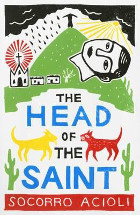The Head of the Saint by Socorro Acioli

Translated by Daniel Hahn. Hot Key Books, 2014. ISBN 9781471402906
(Age: Adolescents - Adults) Highly recommended. The cover and title
both suggest the unusual content of this novel, and the reader is
not disappointed. The story begins with a young boy who is
desperately trying to get to an address he clutches in his hand,
stumbling along a rough country road with no food, or drink or
companions, somewhere it seems, in South America. Acioli is
Brazilian and began this work at a writer's workshop.
After a long walk from town to town, and finding himself ostracized
from the community where his only relative, an old grandmother
lives, Samuel takes to the mountain where he finds shelter and some
solace curling up in the 'head' of the title, the head from a large
statue of a saint that has fallen and left on the ground. Samuel's
story is simple and at times confusing to the reader, told as it is
in translation in a story-telling mode that is circular and embedded
deeply in the culture from which it comes. Yet it is delightfully
simple and charming, even when time is convoluted and dead people
seem to be alive again.
When characters in the novel are revealed as having died years
before, we are positioned to accept this time-warp, as Samuel's
grandmother is depicted, early in the story, as not interested in
saving the life of her grandson, yet we find out later that she died
years before. When Samuel reveals that he 'hears' things when he is
in the head of the saint, he becomes a modern celebrity, and the
town is changed.
Not all people are good, we discover, and, drawn into the
repetitive, circular narrative, we have to work to trace the real
story line as the past and present become interwoven, statues of
saints talk to characters, and sing, and dead people are sometimes
alive and sometimes just bodies on a bed.
Dedicating her story to Gabriel Garcia Marquez and others, Acioli's
narrative is preceded by two quotations that suggest time as more
fluid than it is usually depicted in the western world, 'time as a
place', and that we ought to let go of our expectations if we are to
be involved, indeed to relish, being in such a tale as this one,
which is, ultimately, about simple human kindness.
Suitable for adolescent readers, and adults, who are happy to be
taken out of their comfort zone, and to see the world depicted in a
different light.
Liz Bondar